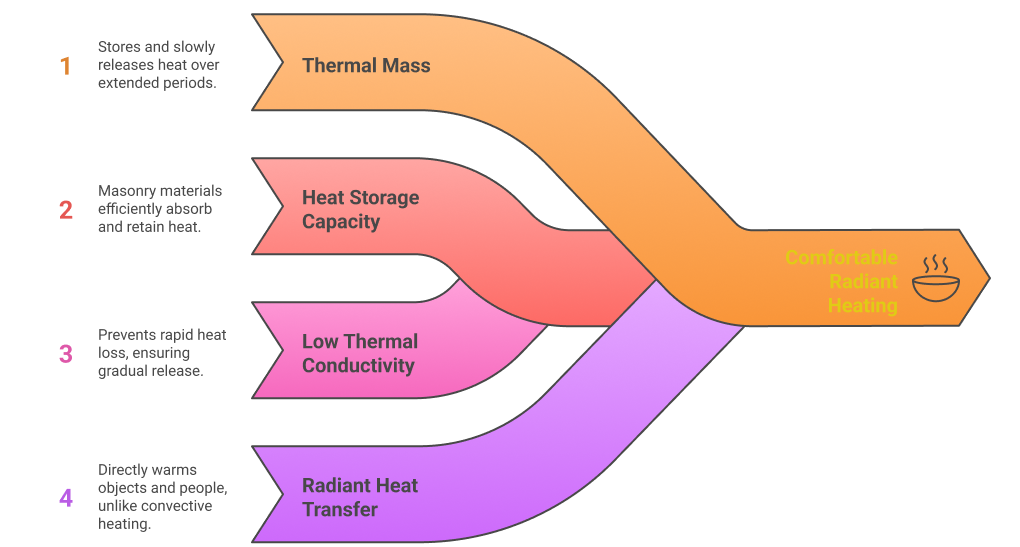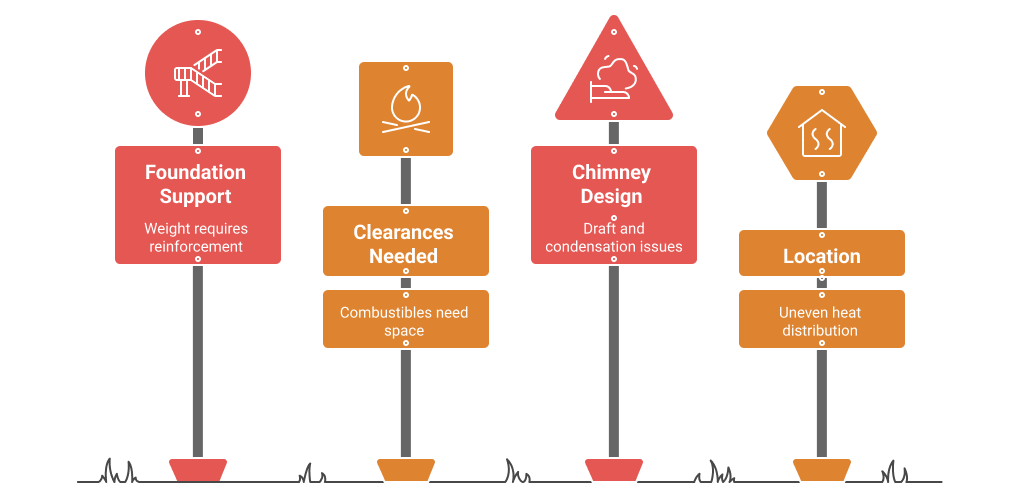In an era of rising energy costs and environmental consciousness, homeowners are rediscovering an ancient heating technology that combines exceptional efficiency with sustainable warmth. Masonry heaters, also known as Russian fireplaces or Finnish stoves, represent centuries of refined engineering that captures and stores heat in ways that modern heating systems struggle to match. Understanding how these remarkable heating systems work can help you determine if a masonry heater is the right choice for your home.
Unlike conventional wood stoves that burn wood slowly and continuously, masonry heaters operate on a fundamentally different principle. They burn wood at extremely high temperatures for short periods, then store and slowly release that heat over many hours through their massive thermal mass. This unique approach results in heating efficiencies of 85-95%, far exceeding traditional fireplaces and rivaling modern heating systems.
The Science Behind Masonry Heater Efficiency

The secret to masonry heater performance lies in complete combustion and thermal mass storage. When wood burns at temperatures exceeding 1,100°F (593°C), it achieves nearly perfect combustion, converting almost all available fuel into heat energy while producing minimal smoke and emissions. This high-temperature burn is possible because masonry heaters are designed with precise air flow controls and combustion chambers that maintain optimal burning conditions.
The combustion process occurs in three distinct phases within the heater. Primary combustion burns the solid wood, releasing volatile gases. Secondary combustion then burns these gases at even higher temperatures, extracting additional energy that would otherwise escape up the chimney. Finally, any remaining particles are consumed in the tertiary combustion zone, ensuring maximum fuel efficiency and minimal waste.
Traditional wood stoves operate at much lower temperatures, typically 400-600°F (204-316°C), which results in incomplete combustion. This lower temperature burning produces creosote, reduces efficiency, and creates more pollution. The high-temperature burn of masonry heaters eliminates these problems while extracting far more energy from each piece of wood.
Thermal Mass: The Heart of Radiant Heating
The true innovation of masonry heaters lies in their thermal mass – typically 1,500 to 8,000 pounds of stone, brick, or specially designed masonry materials. This enormous mass acts like a massive battery, storing the intense heat generated during the brief, hot burn and then slowly releasing it over 12-24 hours.
The thermal mass principle works because masonry materials have excellent heat storage capacity and low thermal conductivity. During the firing period, which typically lasts 1-3 hours, the masonry absorbs tremendous amounts of heat energy. The thick walls heat up gradually, storing this energy within their molecular structure. Once the fire dies down, this stored heat begins radiating outward, warming the surrounding space through gentle, consistent radiant heating.
This radiant heat transfer is fundamentally different from the convective heating produced by forced-air systems. Radiant heat warms objects and people directly, rather than heating air that then warms objects. The result is more comfortable, even heating that doesn’t create hot and cold spots or the dry, dusty air circulation associated with conventional heating systems.
The Internal Architecture: Combustion Chambers and Heat Exchange
Masonry heaters feature sophisticated internal designs that maximize heat extraction from the burning wood. The firebox, constructed from refractory materials that withstand extreme temperatures, provides the ideal environment for complete combustion. These materials, typically refractory brick or special heat-resistant concrete, can handle temperatures exceeding 2,000°F (1,093°C) while maintaining structural integrity.
The heated gases from combustion don’t travel straight up the chimney as they do in conventional fireplaces. Instead, they follow a carefully designed path through internal channels called heat exchangers or baffles. These serpentine pathways force the hot gases to travel horizontally and sometimes downward through the masonry mass before exiting through the chimney.
This extended pathway serves two critical functions. First, it dramatically increases the surface area contact between hot gases and masonry, allowing maximum heat transfer into the thermal mass. Second, it extends the time gases spend inside the heater, ensuring they cool significantly before exiting. While a conventional fireplace might send gases up the chimney at 600-800°F (316-427°C), masonry heaters typically exhaust gases at only 200-350°F (93-177°C).
Heat Distribution and Radiant Comfort
The massive thermal mass of a masonry heater creates an entirely different heating experience compared to other systems. The surface temperature of the heater typically ranges from 120-180°F (49-82°C) during the heat release phase – warm to the touch but not dangerously hot. This moderate surface temperature combined with the large radiating surface area creates gentle, penetrating warmth that heats people and objects throughout the room.
Radiant heating from masonry heaters provides several comfort advantages. Because it warms objects directly, you feel comfortable at lower air temperatures, potentially reducing overall heating needs. The heat doesn’t rely on air circulation, so it won’t spread allergens or create drafts. The steady, even heat output eliminates the temperature swings common with other heating systems.
The thermal flywheel effect means that once heated, a masonry heater continues providing warmth even during power outages or when you’re away from home. This thermal stability creates a consistent comfort level that many homeowners find superior to conventional heating systems.
Fuel Requirements and Burning Practices
Masonry heaters achieve their exceptional efficiency partly through specific fuel and burning requirements. They perform best with well-seasoned hardwood that has been dried to 20% moisture content or less. Dry wood burns hotter and cleaner, maximizing the high-temperature combustion that makes masonry heaters so efficient.
The burning process involves loading the firebox with 40-80 pounds of wood, depending on the heater size and heat requirements. This large fuel load burns rapidly and intensely for 1-3 hours, generating tremendous heat that the masonry mass absorbs. Unlike wood stoves that burn continuously, masonry heaters typically require only one or two firings per day, even in cold weather.
This batch-burning approach requires a different mindset from conventional wood heating. Instead of maintaining a continuous fire, you build a hot, fast fire that burns completely, then rely on the stored heat for warmth. The timing of fires depends on outdoor temperature, thermal mass size, and heating needs, but most homeowners develop an intuitive sense of when to fire their heater.
Emissions and Environmental Impact
The complete combustion achieved in masonry heaters results in remarkably clean emissions. Because wood burns at optimal temperatures with adequate oxygen supply, masonry heaters produce minimal smoke, particulates, and creosote. Many masonry heaters easily meet or exceed EPA emissions standards without requiring complex emission control devices.
The high efficiency also means masonry heaters consume significantly less wood than other wood-burning systems for equivalent heat output. A masonry heater might use 3-5 full cords of wood annually for primary heating, while a conventional fireplace could consume 8-12 cords for similar heat output. This reduced fuel consumption translates to lower environmental impact and heating costs.
The clean burning characteristics also mean less chimney maintenance. The minimal creosote production reduces fire risk and extends intervals between chimney cleanings. Many masonry heater owners report needing professional chimney cleaning only every 2-3 years, compared to annual cleaning recommended for conventional wood stoves.
Installation Considerations and Requirements

Installing a masonry heater requires careful planning and professional expertise. The massive weight necessitates proper foundation support, typically requiring a reinforced concrete pad extending below the frost line. The thermal mass and heat output also require adequate clearances from combustible materials, though these clearances are often less than required for metal wood stoves due to the lower surface temperatures.
Proper chimney design is crucial for masonry heater performance. The chimney must provide adequate draft to support the intense combustion while handling the lower exhaust temperatures. Many installations benefit from insulated stainless steel chimney liners to maintain proper draft and prevent condensation issues.
Location within the home significantly impacts heating effectiveness. Central placement allows radiant heat to reach multiple rooms, while corner installations might focus heat in one area. Professional installation ensures optimal placement for both heating performance and safety compliance with local building codes.
Ready to Experience Superior Home Heating?
Masonry heaters represent the perfect marriage of ancient wisdom and modern efficiency, providing unmatched comfort while reducing environmental impact and heating costs. Their unique combination of complete combustion, thermal mass storage, and radiant heat distribution creates a heating experience that conventional systems simply cannot match.
Discover how a custom masonry heater can transform your home heating experience.
Contact Greenstone Masonry Heaters today for a consultation and learn why thousands of homeowners are choosing masonry heaters for efficient, comfortable, and sustainable warmth. Call Us now to schedule your free assessment and take the first step toward heating independence.

Leave a Reply